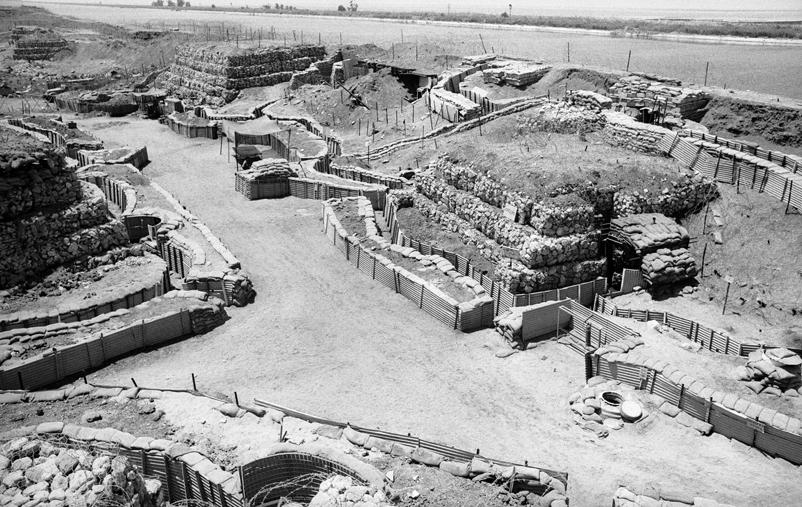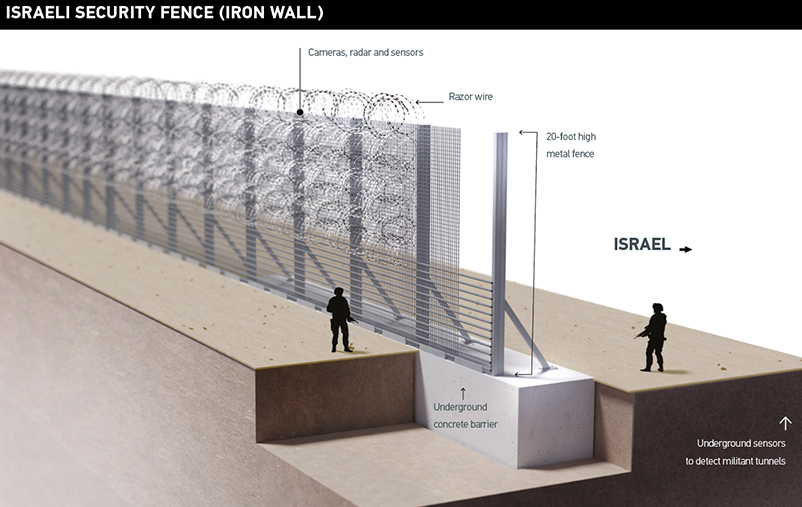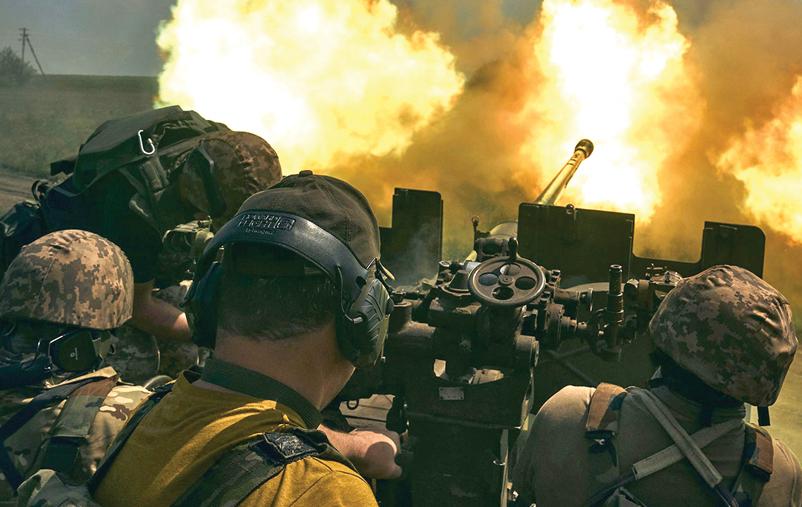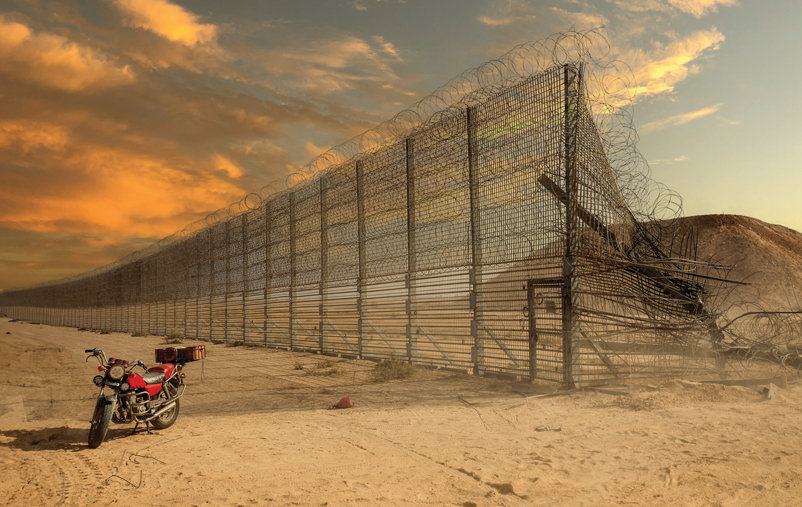Military barriers and fortifications have long held a prominent position in military history, being present in many modern wars, especially those witnessed worldwide from the 19th to the 21st century. Notable examples include the German Siegfried Line (1916 – 1917), the French Maginot Line (1929 – 1938), and the Israeli Bar Lev Line (1968 – 1973).
In military science, fortifications and barriers are defined as fixed structures erected to strengthen the defensive position of one state against an adversary. These fortifications are usually of two types: permanent and field fortifications.
Permanent fortifications, such as forts and troop shelters, are often constructed during peacetime or when the threat of war arises.
On the other hand, field fortifications are created during military confrontations or when the threat of war is imminent.
Forts typically consist of fortified positions for individuals and weapons, obstacles such as explosive mines, barbed wire, anti-tank trenches, and more. Field and permanent fortifications often benefit from natural obstacles, such as channels and rivers, and are usually camouflaged or concealed.
Objectives of Fortifications and Barriers
The objectives of fortifications and barriers include enhancing the firepower of defending forces, providing cover to protect entrenched forces behind these barriers, and hindering the advance of enemy forces or restricting their movement by forcing them into specific paths.
While their primary role is defensive, barriers sometimes play a role in seizing new territories, contributing to defensive and offensive strategies.
In contemporary wars, the most prominent examples of defensive fortifications are the Russian “Suroviken Line” and the Israeli Iron Wall.
The review of various historical cases led to the belief that military barriers do not always live up to their expected effectiveness when constructed.
The anticipation of their ability to withstand counterattacks is usually high, leading to strategic surprises when these fortifications unexpectedly collapse.
This can be observed in historical cases such as the German Siegfried Line, the French Maginot Line, and the Bar Lev Line.
This study aims to understand this issue by proposing the following hypothesis: fortifications are more effective when they are part of an advanced defensive strategy that takes advantage of environmental and geographical factors on the battlefield.

Defensive lines alone are not a specific factor for victory or defeat; it depends on the defensive strategy adopted by the armed forces of the concerned state.
This hypothesis will be tested by applying it to two cases: the Russian Suroviken Line in Ukraine and the Israeli Iron Wall around the Gaza Strip. The former was tested in mid-2023 when Ukrainian forces launched their counterattack, while the Israeli wall was tested on October 7, 2023.
The Suroviken Line
The term “Suroviken Line” gained prominence in Western media towards the end of 2022, used to describe the defensive lines established by the Russian army along the front. The designation is linked to the former commander of the Russian forces in the special military operation zone, Sergei Suroviken.
The Suroviken Line consists of three defensive lines, with a final line featuring trenches and “Dragon’s Teeth,” which are pyramid-shaped concrete obstacles designed to slow down vehicles and armoured units, forcing them to move in straight lines, limiting their manoeuvrability and making them more susceptible to targeting and destruction.
Moreover, the Russians also asserted control over the battle’s airspace, whether through their advanced air defence systems or electronic warfare, contributing to the downing of a significant number of Ukrainian drones. Additionally, this disrupted the communication of the attacking Ukrainian forces, depriving them of the ability to coordinate cohesive attacks.
When Ukraine launched its counteroffensive in early June 2023, Ukrainian forces expected minefields. However, they were surprised by the density of mine distribution, covering the ground with explosives. Mine clearance units could only secure narrow passages. As Ukrainian forces advanced using Bradley armoured vehicles or other Western and Soviet-era armoured vehicles on the cleared paths, Russian forces positioned on elevated terrain directed anti-tank missiles, hitting some vehicles in the convoy and forcing others to deviate from the cleared path, leading to mines exploding.
Russian helicopters and drones then targeted the remaining military convoy, compelling the attacking units to withdraw multiple times to reorganize before resuming the assault, resulting in similar bloody outcomes.
In late 2023, General Valery Zalogny, the commander of the Ukrainian Armed Forces, acknowledged that the war in Ukraine had reached an impasse, with limited military gains for Ukraine.
The success of the Russian forces can be attributed to several factors.
Firstly, Russia’s control of the airspace through advanced air defence systems and electronic warfare, which effectively shot down most Ukrainian fighters and drones.
This diminished the Ukrainian Air Force’s ability to effectively counter Russian airstrikes, especially against attacking Ukrainian units.
Moreover, the Ukrainian forces faced challenges in conducting manoeuvres due to minefields and anti-tank trenches.
A senior Ukrainian official acknowledged the Russian air superiority, highlighting the limitations of Ukrainian MiG-29 fighters with a detection range of 40 miles and a firing range of up to 20 miles.
In contrast, Russian Su-35 fighters could detect targets beyond 90 miles and engage them from a distance of up to 75 miles. While Ukrainian officials blamed their American counterparts for the delayed supply of F-16 fighter jets, a high-ranking American defence official asserted that even if Kyiv had been supplied with F-16s, they would have been swiftly defeated on the first day due to the formidable and highly capable Russian air defences in Ukraine.
The second factor is the failure of the Western military theory, which deemed fixed fortifications militarily irrelevant due to the evolution of precision artillery.
This type of artillery can be employed to target enemy fortifications with high accuracy, leading to their destruction. Additionally, the West relied on the tactic of joint arms manoeuvres, aiming to utilize ground and air forces simultaneously in attacking enemy fortifications.
However, Russia, in contrast, thwarted this Western reliance on advanced weaponry and joint manoeuvres by employing a network of intricate fortifications that proved difficult to destroy.
The third factor lies in the West’s underestimation of the capabilities of the Russian army. The misguided belief of the Western countries supporting Ukraine was rooted in the U.S. military intelligence’s assumption that Russian defences in Ukraine were weak, lacking sufficient forces for defence, and experiencing a collapse in morale among Russian troops.
Intelligence reports even suggested that Russian leaders believed their chances of victory in the war against Ukraine were limited. However, these conclusions later proved inaccurate.
In a short period, the Russians successfully built military fortifications spanning over a thousand kilometres with a depth of fifty kilometres, revealing their highly advanced military engineering capabilities.

Ukrainian counter-attacks
On the other hand, what enabled the Russian forces to repel the Ukrainian counter-attack was not only the military fortifications but also the military tactics employed, specifically the “defence in depth” strategy, also known as flexible defence. This military strategy involves constructing multiple layers of defensive lines to slow down or halt the enemy’s advance. The objective is to make it challenging for the enemy to penetrate the country’s defences as much as possible, forcing them to fight on multiple fronts.
This, in turn, can weaken their resolve and deplete their resources, hindering their ability to continue the fight.
Moreover, this strategy involves leveraging the terrain and geographical features, such as mountains, swamps, and rivers to create defensive barriers that can impede or halt the enemy’s progress. As a result, Russia was able to inflict severe losses on Ukraine by implementing this strategic approach.
The Impenetrable Wall
Military barriers play a crucial role in Israel’s military doctrine, given its lack of strategic and tactical depth. Most of its population falls within the artillery range of neighbouring countries, including small arms in many cases.
Additionally, Israel faces challenges in rapidly and repeatedly mobilizing reserve forces. These factors have led Israel to rely on defensive walls, especially when deterrent mechanisms and early warning fail to address security threats.
An example of this is the Bar Lev Line, initiated in 1968 and failed by 1973, just five years after its construction. The Bar Lev Line consisted of around 30 fortified points, spaced seven miles apart, supported by mobile armoured forces stationed away from the canal to thwart Egyptian attacks.
Approximately 14 of these fortified points were unoccupied and lacked defending forces during the 1973 Egyptian attack. The manned points had around 15 Israeli soldiers, but they lacked sufficient ammunition to qualify as strong defensive positions. When the Egyptian forces attacked the unmanned units, they failed to impede the Egyptian advance or redirect the attack toward easily defensible paths. Consequently, the Bar Lev Line failed to provide early warning to Israeli forces or thwart the Egyptian assault, resulting in Israel’s most significant defeat of the 20th century.
Despite Israel’s efforts to learn from the lessons of the October 6, 1973 war, it became apparent that these lessons were not heeded when Hamas launched an attack on October 7, 2023, against the Israeli Security Fence.
Israel spent over 1.1 billion USD in recent years to build a multi-layered security barrier along its border with the Gaza Strip, spanning about 40 miles. Israel claimed it to be the most fortified fence ever, composed of wire, steel, and concrete barriers, standing 20 feet high.
The “smart fence” integrated a vast network of cameras, motion sensors, radars, and remotely controlled weapon systems, all monitored by dozens of towers, making it a highly technologically advanced surveillance and defence centre.
Additionally, the barrier extended underground to prevent tunnel infiltration, covering the entire border with Gaza, while the advanced Israeli missile defence system, “Iron Dome,” protects the skies, ensuring complete protection against potential threats.
The Evolution of Israeli Strategic Doctrine
Recognizing its lack of strategic depth, Israel has developed the strategy of “Operational Depth,” consisting of three components. The first is “Deep Operations,” also known as “Mabam” in Hebrew, meaning the war between wars or perpetual low-intensity warfare. This is also known in Israel as the “Active Deterrence” or pre-emptive war. The general objective of these wars is to continually pressure the adversary, “depleting its strength” by systematically targeting emerging military capabilities within its territory, to delay the next “major war.”
Technological advancements, particularly artificial intelligence and intelligence gathering enable the rapid detection of any hostile ammunition launches and engagement with them through a network of missiles within any military formation of the Israel Defence Forces (IDF).
The second component, “Frontal Depth,” addresses threats coming from nearby regions and distant areas like Iran. This involves establishing external bases to defend Israel, such as in Azerbaijan, Cyprus, or other neighbouring countries.
The third component involves having sufficient reserve forces, enabling the IDF to make a qualitative leap from defence to offence. In other words, the Israeli triad consists of the ability to deploy force, absorb threats, and conduct ground manoeuvres, in addition to airstrikes.
This approach aims to inflict severe losses on the enemy, leading to the restoration of deterrence by forcing the adversary to think twice before attacking Israel.
The attack on October 7th has challenged several components of the Israeli strategy. The last time Israel engaged in a ground war in Gaza was in 2014, lasting 50 days, causing significant damage and casualties. However, this did not deter Hamas from launching the October 7, 2023 attack.
On the other hand, Israel failed to limit Hamas’s military capabilities, as its strategy of wars between wars to trim the strength of its adversaries proved ineffective against Hamas.
The IDF relied on a combination of operational superiority and intelligence to weaken and destroy Hamas’s capabilities and infrastructure.
The assumption was that periodic use of force was enough to compel Hamas to reevaluate the effectiveness of its attacks, at least until it could rebuild its capabilities destroyed by Israel.
However, the October 7th attack revealed that Israel did not anticipate the growth of Hamas’s strength to the extent that it could launch a coordinated attack by land, sea, and air simultaneously.
This attack made it clear that Hamas’s capabilities evolved rather than diminished. Furthermore, Israel’s sweeping attack on Gaza did not deter other groups like Hezbollah in Lebanon from launching attacks against Israel, confirming the collapse of Israel’s deterrence strategy, a fundamental pillar of its defence doctrine.

Israel’s belief in its technological and military superiority over its adversaries, particularly groups like Hamas, led to a false sense of security. The best example of this is the “smart” border fence, a barrier along the Gaza Strip that is 20 feet high, 40 miles long, and equipped with advanced sensors and remotely operated machine guns.
The fence, also known as the Iron Wall, gave Israel a misguided belief that there was no need for a large number of Israeli soldiers on the ground to protect against potential attacks from Hamas, which allowed for the deployment of more ground forces to the West Bank and other areas.
This false sense of security was further exacerbated by the belief that the Iron Dome missile defence system, introduced in 2011 and designed to intercept short-range and artillery rockets, would provide sufficient protection against missile and artillery attacks from Gaza and southern Lebanon in the event of a widespread regional conflict.
This reinforced the perception that there were no tough strategic choices for Israel to make, given its advanced capabilities in intelligence, surveillance, and reconnaissance, which made Gaza, southern Lebanon, and the West Bank some of the most monitored territories in the world by Tel Aviv. Israelis believed that this would provide enough warning to respond to any emerging military threat, yet it became evident that Israel couldn’t detect and effectively deal with Hamas’ coordinated attack.
This belief in technological superiority directly influenced the Israeli army’s tactical planning, shaping a strategic doctrine that relied more on defence and firepower, specifically prioritizing airstrikes, rather than conducting ground manoeuvres with infantry forces to achieve military objectives.
Concerning the other side of the equation, the October 7th attack took months of intricate preparation from Hamas. This was evident in Hamas launching approximately 5000 rockets in a short period against Israel, aiming to paralyze the Iron Dome system due to its inability to track and intercept every incoming rocket. As a result, the system ultimately failed to intercept any of them.
Simultaneously with the rocket attack against Israel, units of Hamas conducted numerous coordinated and direct assaults on 27 different locations. The furthest point Hamas penetrated was the town of Ofaqim, located 22.5 kilometres east of Gaza.
Hamas used various methods to breach the Israeli border fence, such as using bulldozers to demolish parts of the wire-covered fence in lightly guarded areas. In heavily fortified areas, Hamas units detonated the concrete barrier, then attacked heavily fortified Israeli checkpoints, killing those within. Some Hamas fighters attempted to bypass the barrier entirely by flying over it using paragliders and boats.
Thus, Hamas not only aimed to destroy the Israeli border fence but also to successfully attack Israel’s defensive strategy.
On the other hand, there is a clear similarity in the failures of October 6 and 7; in both cases, Israel thought its fortifications were impregnable and that it could rely on them to repel any security threat, only to be proven wrong on both occasions.
Conclusion
Upon reviewing the two aforementioned cases, it can be asserted that the Russian fortifications facing the Ukrainian army have proven highly effective. This is despite the West’s belief that fixed defences are useless.
The Russian army’s success lies in the organization of extensive, multi-layered defensive lines coupled with the successful implementation of a deep defence strategy. This strategy exhausted attacking units of the Ukrainian army, resulting in significant human and material losses.
In contrast, Israel’s reliance on the Iron Wall, advanced technology, and its attempt to use a limited number of military forces to encircle and isolate the Gaza Strip, ultimately proved unsuccessful.
This failure is evident in Hamas’s ability to breach Israeli defences. It is also apparent that Israel’s superiority in surveillance, reconnaissance, and espionage did not meet the expected level of precision. Israel failed to foresee the evolution of Hamas’ military capabilities, which despite its heavy losses in 2014, managed to develop its military capabilities. Hamas even studied Israeli military capabilities, especially in technology, and devised tools to confront and overcome them.
All of this indicates that defensive fortifications can achieve military victory if a realistic and suitable defensive strategy is adopted. Such a strategy should be based on precise assessments of the strengths and weaknesses of both the defending nation and its adversaries.
» By: Dr Shadi Abdelwahab (Associate Professor at the National Defence College – Abu Dhabi)













